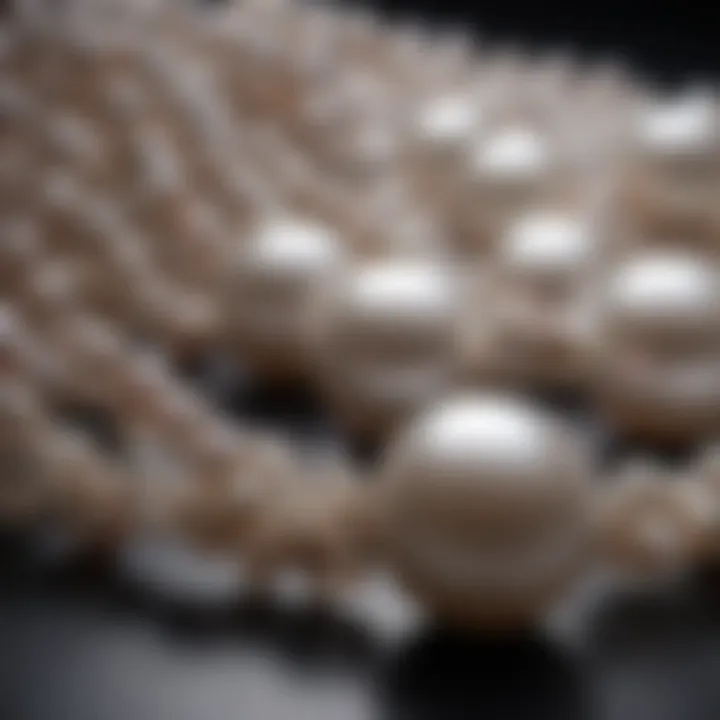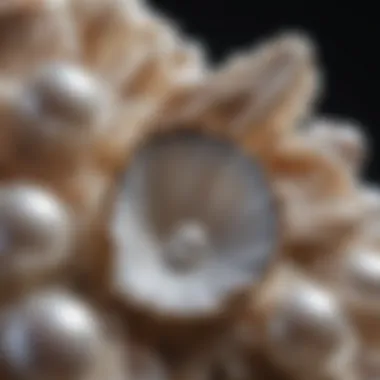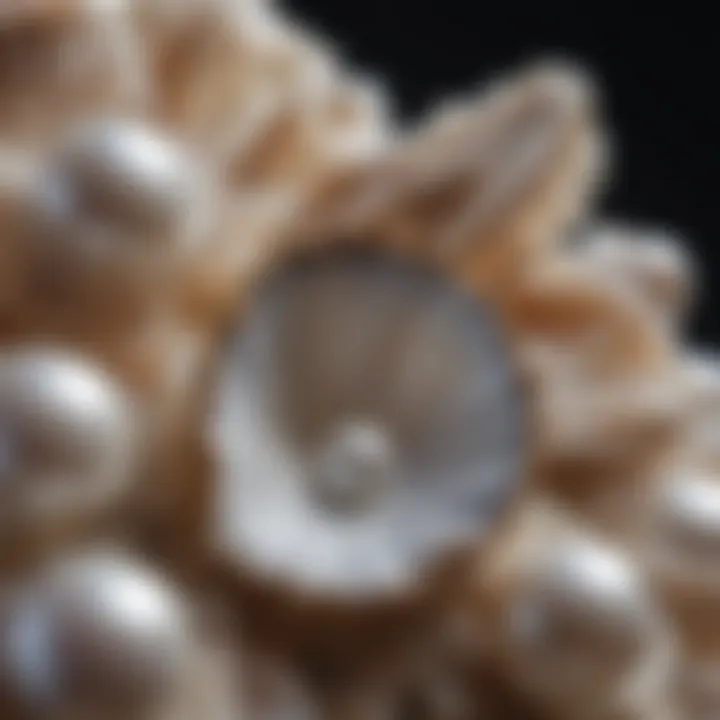Understanding Cultured Pearls: An In-Depth Study


Intro
Cultured pearls, often hailed for their elegance and charm, have carved out a notable niche in the world of gemstones. These beautiful gems not only carry aesthetic appeal but also tug at the strings of history, culture, and ethics in contemporary practices. Understanding cultured pearls means unraveling narratives that encompass intricate cultivation techniques and a rich tapestry of human artistry.
As we plunge into this exploration, we’ll uncover the foundational aspects of cultured pearls, including their definitions, characteristics, and classifications. There's more here than meets the eye; it’s about appreciating the labor and love woven into each lustrous sphere. By the end of this piece, readers should find themselves more informed and perhaps even moved by the stories behind these unique gems.
This journey through the world of cultured pearls isn’t just for gem enthusiasts or collectors—it's also for those who wish to understand the cultural implications tied to these gems and how ethical considerations, like farming practices, shape our appreciation of them. Whether you’re a jeweler designing the next beautiful piece or simply a seeker of knowledge, you’re in for quite a treat.
Defining Cultured Pearls
Cultured pearls represent an exquisite intersection of nature and human innovation, serving as valuable gemstones that have fascinated people for centuries. They hold an important place in the jewelry market, not just for their beauty but also for their intricate creation process. Understanding cultured pearls is essential for anyone who has a keen interest in gemstones, whether they are collectors, designers, or simply enthusiasts. The topic sheds light on the characteristics that differentiate cultured pearls from their natural counterparts, emphasizing how they are cultivated with human intervention.
Defining what a cultured pearl truly is, allows individuals to appreciate the artistry and complexity involved in their formation.
Historical Context
Historically, pearls have been revered across cultures and time periods. From the ancient Egyptians who adorned themselves with pearls in burial rites to the Chinese who viewed them as symbols of wisdom and virtue, pearls have consistently been associated with status and beauty.
The story of cultured pearls began in the early 20th century when the concept of farming pearls was pioneered by Kokichi Mikimoto in Japan. This marked a significant shift in the pearl industry, as it allowed for a more reliable and sustainable source of pearls. As these practices developed, they revolutionized how pearls were viewed—moving from fantastical treasures found in the wild to cultivated gems harvested under controlled conditions. The cultural implications are profound, leading to an appreciation that balances both nature's artistry and human skill.
Scientific Definition
From a scientific standpoint, a cultured pearl is a gemstone formed within the soft tissue of a living mollusk, typically an oyster or a mussel. The process involves a technique called nucleation, where a small bead or piece of tissue is implanted into the mollusk. This prompts the mollusk to secrete layers of nacre, a combination of calcium carbonate and organic materials, which eventually forms the pearl.
Unlike natural pearls, which occur spontaneously, cultured pearls are intentionally cultivated, which introduces several variables that influence their quality. Various factors like the type of mollusk, the environment, and even the technique used for nucleation play crucial roles in determining the final product. Therefore, while the anatomical and biochemical processes are aligned with natural pearl formation, the guided approach in cultured pearls offers insights into human ingenuity and the quest for perfection in this field.
“Cultured pearls are an amalgamation of nature's elegance and human craftsmanship.”
To summarize, defining cultured pearls is not just about understanding their formation; it's about grasping their evolution through history and the scientific methods that establish their uniqueness. For those delving into the world of jewelry design or collection, comprehending these foundational elements enhances appreciation and informs better decision-making.
The Formation Process
Understanding the formation process of cultured pearls is crucial in grasping their unique characteristics and value. It’s not merely a natural phenomenon; it’s a deliberate art that combines nature and human ingenuity. In this section, we’ll explore the nucleation and growth stages that produce these lustrous gems. By digging into these details, readers can better appreciate not only the beauty of cultured pearls but also the complexity behind them.
Nucleation
Nucleation is the starting point in pearl formation. This step involves inserting a foreign object, usually a small bead, into the mollusk, prompting it to produce a pearl.
Mechanics of Nucleation
The mechanics of nucleation play a pivotal role in the overall pearl production process. When a bead is inserted, it triggers the mollusk’s natural defense mechanism, leading to the secretion of nacre layers. A key characteristic here is how effectively the mollusk can coat the bead with nacre; the more layers formed, the larger and more lustrous the pearl.
This method is a popular choice for pearl farmers because it allows consistent control over the size and shape of the pearls produced. However, there’s a unique feature in how various mollusks respond to nucleation—some species produce pearls faster or with more appealing color than others. This divergence presents advantages but also challenges; not all attempts lead to a successful or desirable outcome.
Materials Used
The materials used in nucleation are just as crucial as the process itself. The most common material is a polished bead, often made of mother-of-pearl or plastic, which serves as the nucleus around which nacre builds.
A key characteristic of the materials used is their compatibility with the mollusk. For example, mother-of-pearl beads tend to be the preferred choice because they mimic the natural interior of the mollusk, promoting better acceptance and coating. This choice is beneficial as it can result in a higher-quality pearl; however, there are disadvantages too. Not all materials interact well with every type of mollusk, which can lead to inconsistent results.
Growth Stages
After the nucleation process, the pearl enters various growth stages, crucial for developing the final product’s beauty and quality.
Initial Layers
The initial layers of nacre laid down after nucleation are fundamental to the pearl's eventual appearance. They act as the foundation for what follows, and if they are uneven or poorly constructed, the final pearl will reflect that. A defining characteristic is the speed at which these nacre layers accumulate; different mollusks have varying growth rates depending on their species and environmental conditions.


The beauty here lies in how the mollusk instinctively creates layers, forming a stunning jewel from something as simple as irritation. This process makes cultured pearls intriguing for collectors and jewelry designers, although the uneven growth in initial stages can pose challenges. It requires a keen eye and experience to anticipate how early growth affects final outcomes.
Development of Luster
Luster is the crowning glory of any pearl and develops significantly during the growth stages. As layers of nacre build, they begin to reflect light, creating that soft, glowing effect most people associate with high-quality pearls. A unique aspect of luster is its variability; factors such as the thickness of nacre and even the water quality affect it.
The rich sheen that results from high-quality nacre buildup makes cultured pearls desirable in the jewelry market. However, to attain that coveted luster, patience is needed—the longer pearls are allowed to grow, the more defined their luster becomes. Yet, with this comes a caveat; prolonged growth can also lead to increased risk of imperfections if not monitored carefully.
Cultured vs. Natural Pearls
When discussing pearls, it is crucial to draw a line between cultured and natural pearls. This distinction not only plays a significant role in how we perceive these gems but also impacts their value, quality, and the ecological dynamics involved in their formation. Understanding this difference helps collectors and enthusiasts make more informed decisions while acquiring pearls, whether for personal wear or investment purposes.
Differences in Formation
The formation process serves as the basis for distinguishing cultured pearls from their natural counterparts. To put it plainly, natural pearls appear when an irritant, such as a grain of sand, accidentally enters a mollusk. The creature then responds by secreting layers of nacre around the irritant over time, leading to the formation of a pearl.
In contrast, cultured pearls undergo human intervention. Farmers intentionally introduce a foreign object, known as the nucleus, into the mollusk. Given the controlled circumstances overseen by pearl farm operators, the process can be streamlined and results can be more predictable.
It's worth noting that the host mollusks for natural pearls, namely oysters and mussels, can be fickle and rare. Therefore, the production of natural pearls is highly limited and cannot simply be replicated at will. Here are a few key differences in their formation:
- Origin: Natural pearls form without human intervention, while cultured pearls require it.
- Control: Cultured pearls are produced under controlled conditions, reducing the unpredictability associated with nature.
- Time Frame: Given the precise methods employed, cultured pearls can typically be harvested within a set time frame, unlike natural pearls that can take years or even decades to form.
Market Value Comparison
Market dynamics reveal substantial differences when it comes to pricing between cultured and natural pearls. Natural pearls, as stated earlier, come from random acts of nature and their scarcity adds significantly to their value. Some of these pearls can fetch astronomical prices, often reaching tens or hundreds of thousands of dollars at auctions.
Cultured pearls, on the other hand, generally fall into a more accessible price range. Since they are produced in larger quantities, their market value is usually lower than that of high-quality natural pearls. Nevertheless, certain types of cultured pearls, especially those with exceptional luster or unique colors, may still command impressive prices.
Here’s a simple breakdown of the key price influencing factors:
- Scarcity: Natural pearls are rare, often leading to higher prices.
- Quality: High-quality cultured pearls can still be valuable, depending on their attributes.
- Market Trends: A growing interest in pearls can influence the prices of both types, but natural pearls will typically remain more prized among purists.
"Understanding the differences between cultured and natural pearls is essential for anyone looking to invest in or appreciate these gems deeply. Know what you are paying for!"
Factors Influencing Pearl Quality
When discussing cultured pearls, the quality of each pearl can make or break its value in the eyes of collectors and jewelers alike. Therefore, understanding the factors influencing pearl quality is key to appreciating these underwater gems. Significant elements such as shape, size, surface quality, luster, and color all contribute to the overall allure and market demand for cultured pearls. Each characteristic comes with its unique benefits and considerations, which directly affect the pricing and desirability of these pearls.
Shape and Size
The shape and size of a cultured pearl are often regarded as primary indicators of its quality. Round pearls, known for their symmetrical beauty, tend to be the most sought after, commanding premium prices. However, other shapes, often referred to as "baroque" pearls, can carry a unique charm as well. These irregularly shaped pearls allow for individuality in jewelry design, appealing to collectors who cherish distinctiveness.
Size matters too—larger pearls are generally rarer and more valuable. A pearl's size is measured in millimeters, and while many buyers seek pearls above a certain size, it depends on personal preference too.
Surface Quality
Imperfections and Blemishes
Surface quality has a profound impact on the visual appeal of cultured pearls. Every pearl is unique and many will bear their own imperfections, which can range from minor bumps to noticeable blemishes. These imperfections can serve as markers of authenticity, and while they might diminish the pearl's aesthetic value, they can also contribute to its story. For instance, a pearl with character might attract those who appreciate pearls that showcase their natural origins, imperfections and all.
A key characteristic of blemishes is that they are the result of the natural formation process. The uniqueness of each pearl means that such imperfections play a role in adding to the charm and individuality of a piece of jewelry. Collectors often consider these details desirable because they help to differentiate one pearl from another.
Grading Standards
Understanding the grading standards when evaluating surface quality is vital. The most reputable sources rely on an established grading system, which usually categorizes surface quality into categories such as A, B, and C. A-grade pearls typically have minimal imperfections and preserve their luster remarkably well, companying excellent value in the market.
On the other hand, B and C grades might have more noticeable flaws, therefore offering a lower price point. Grading standards weed out discrepancies, making it easier for buyers to understand what they're getting. However, it’s prudent to remember that quality grading can vary between different sellers, so always consider getting a certification from an authoritative source to verify the claimed grade.
Luster and Color


The luster of a pearl—its shine and reflection—is often described as its most captivating attribute. A high-luster pearl will appear almost mirror-like, reflecting light superbly, while a lower-quality pearl may look somewhat dull. Generally, high luster is associated with better quality, attracting collectors' prying eyes.
Color is equally important—cultured pearls come in a range of hues from classic white to deep black, or even golden yellow. The color affects the overall impression of the pearl and how it pairs with different styles of jewelry. For example, black Tahitian pearls, with their exotic tone, are often favored in high-end jewelry, while lighter shades like Akoya pearls remain popular for more traditional pieces.
In summary, factors like shape, surface quality, luster, and color play integral roles in determining the quality and value of cultured pearls, thus helping enthusiasts and collectors in their pursuit of exceptional pieces. By recognizing these characteristics, buyers can make informed choices that resonate with their personal style and investment goals.
Cultured Pearl Types
Cultured pearls come in an array of types, each with its unique characteristics, origins, and market values. Understanding these varieties is crucial not just for collectors and enthusiasts, but also for those seeking to understand the full scope of the cultured pearl industry. Each type of pearl bears its own narrative, reflective of the environment where it was formed, the mollusk involved, and, importantly, the techniques used by farmers. When choosing pearls for personal adornment or for investment, the type can dictate not only aesthetic appeal but also price and rarity.
Akoya Pearls
Akoya pearls are perhaps the most recognized type in the world of cultured pearls. Primarily cultivated in Japan and China, these pearls are distinguished by their round shape and high luster. The Akoya mollusk, Pinctada fucata, is a small oyster that produces pearls generally ranging from 2mm to 10mm in size.
Most notably, Akoya pearls are known for their classic white or cream color, often with overtone shades of pink or blue. The luster, which can be described as sharp and mirror-like, comes from the thickness of nacre — the outer layer produced by the oysters.
Akoya pearls are often associated with refined elegance, making them a popular choice for necklaces and earrings. They encapsulate the quintessential image of a pearl, appealing to individuals who favor traditional jewelry styles.
Freshwater Pearls
Freshwater pearls hail predominantly from rivers and lakes, primarily in China. Unlike their seawater counterparts, these pearls come from various mussels and exhibit a wide range of shapes, sizes, and colors, thanks to a more versatile farming process. Ranging from near-round to baroque, freshwater pearls can be as small as 2mm up to 20mm.
The luster of freshwater pearls often has a more subdued quality when compared to Akoya pearls, yet they exhibit beautiful iridescence. It’s not uncommon to find these in vibrant colors like lavender, peach, and even deep blue.
Notably, freshwater pearls are usually more affordable than Akoya or other types, making them a great option for those looking to indulge in pearls without breaking the bank. They provide a versatile choice, suitable for both casual and formal settings.
Tahitian Pearls
Tahitian pearls are known as the black pearls, which can be somewhat misleading. These pearls actually come in a stunning variety of colors, including green, blue, and even aubergine, thanks to the Tahitian black-lipped oyster, Pinctada margaritifera. Cultivated mainly around the islands of French Polynesia, their uniqueness lies in their exotic hues and larger size, typically ranging from 8mm to 16mm.
The beauty of Tahitian pearls is amplified by their natural color variations and the rich, satiny finish they often possess. They are highly coveted in the luxury market and are often seen as statement pieces. Their impressive size and color diversity also convey a sense of uniqueness that appeals to collectors.
South Sea Pearls
South Sea pearls are perhaps the most opulent of all pearl types, characterized by their large size and luxurious luster. These pearls originate from the silver-lipped and gold-lipped oysters found in the warm waters of Australia, Indonesia, and the Philippines. Ranging from 9mm to 20mm or more, South Sea pearls are notable for their impressive scales, often making them show-stoppers in any jewelry collection.
The colors of South Sea pearls typically vary between white, cream, and golden hues, depending on the specific oyster species. Their nacre is exceptionally thick, which contributes to their impressive luster and overall quality. Investing in South Sea pearls is often seen as a move towards collecting a bit of luxury, as they tend to carry a high market value due to their rarity and stunning aesthetics.
Understanding the different types of cultured pearls enhances appreciation for their diversity. Each variety offers unique elements suitable for different preferences and styles, ensuring that everyone can find a type that resonates with their taste.
"The beauty of cultured pearls lies not just in their appearance, but in their story – where they come from, how they are made, and the lives they touch."
By differentiating between these types, collectors, jewelry designers, and gemstone enthusiasts can make informed decisions that reflect their values and personal aesthetics.
Cultural Significance of Pearls
The cultural significance of pearls extends deeper than their aesthetic appeal. These gems have functioned as symbols and artifacts throughout history, transcending mere adornment to embody values, beliefs, and traditions integral to various cultures. Whether involved in rites of passage, used in ceremonial dress, or regarded as tokens of wealth, the impact of pearls within societal contexts is both varied and profound. By delving into the historical usage and the metaphysical beliefs surrounding pearls, one gains a clearer understanding of their enduring allure and significance.
Historical Usage
Pearls have graced many significant moments in human history, often treasured for their rarity and beauty. In ancient civilizations, such as those of China and India, pearls were not just prized possessions but were also associated with royalty and divinity. The Chinese, for example, believed pearls originated from the heavens, symbolizing purity and wisdom. They adorned themselves with these gems during important events, such as weddings or imperial ceremonies, signaling both status and virtue.
In European cultures, pearls saw a new wave of fascination during the Middle Ages, often associated with the Virgin Mary in Christian iconography, representing innocence and perfection. Such historical attachments established pearls as symbols of femininity and were commonly used in religious artifacts and royal regalia. Furthermore, the age of exploration during the 16th century unleashed a pearl craze in Europe, leading to extensive trade, which altered social hierarchies and introduced a myriad of new cultural influences. Notably, the famous pearl, La Peregrina, worn by Elizabeth Taylor, represents both historical ownership and the transitioning taste of different eras.
As time marched on, pearls continued to crop up throughout various cultures, often retaining their connection to status. Today, designers and jewelers often pay homage to this rich history while cultivating innovative uses in modern jewelry.
Metaphysical Beliefs
The allure of pearls does not solely stem from their visual charm; many cultures embrace them for their perceived metaphysical properties. Throughout history, pearls have been thought to carry various powers. For instance, many believe that wearing pearls can promote emotional balance and serenity. This notion is rooted in the idea that the calming energy of the ocean, where pearls are born, bestows a sense of peace upon the wearer.
Other beliefs suggest that pearls can amplify one's personal energy and promote sincerity. They are often associated with enhancing one's ability to express feelings and thoughts, making them popular for those seeking to improve communication or personal relationships. Furthermore, some legends position pearls as protective talismans, safeguarding their owners from negative energies.
"A pearl is a spiritual symbol, often seen as a bridge between inner and outer beauty, reflecting a balance of emotional and spiritual realms."
In contemporary society, such beliefs continue to inspire people. While not everyone may subscribe to these ideas, they contribute to the allure and narrative surrounding pearls, further cementing their status as significant cultural artifacts.
Through understanding the historical usage and metaphysical beliefs associated with pearls, one can appreciate their multifaceted roles in human culture. This rich tapestry of meaning adds to the beauty of these natural gems, inviting gemstone enthusiasts and collectors alike to explore their significance beyond the surface.
Ethical Considerations in Pearl Farming
The cultivation of pearls is not just about creating opulent accessories; it involves a multifaceted relationship with nature and society. In recent years, the conversation around ethical considerations in pearl farming has gained traction, reflecting a greater awareness of environmental and social responsibilities. An ethical approach to pearl farming doesn’t merely serve the interests of producers but also safeguards marine biodiversity and local communities.


Sustainable Practices
Sustainable practices in pearl farming are paramount. These methods are designed to minimize environmental impact while fostering a healthy ecosystem. Farming practices that adhere to sustainability often emphasize:
- Responsible sourcing: Pearl farmers must ensure that the oysters and other marine resources utilized in their operations are harvested responsibly, mitigating the effects of overfishing.
- Organic farming methods: Some pearl farms employ organic techniques that avoid harmful chemicals that could leach into marine environments, promoting the natural health of the mollusks.
- Biodiversity enhancement: Sustainable pearl farming could involve creating artificial reefs or habitats that benefit various marine species, thereby enhancing biodiversity rather than diminishing it.
An example of sustainable pearl farming is found in the methods employed by producers in French Polynesia, where techniques focus on preserving the natural environment while cultivating Tahitian pearls. Their approaches prioritize not only the health of the oysters but also respect the delicate marine ecosystem surrounding them.
Impact on Marine Ecosystems
The impact of pearl farming on marine ecosystems cannot be understated. When managed poorly, pearl farms can lead to drastic consequences, including:
- Habitat destruction: Intensive farming practices can damage the seabed and surrounding habitats, disturbing local flora and fauna.
- Pollution: Runoff from pearl farms can introduce contaminants and excess nutrients into the water, leading to algal blooms that disrupt aquatic life.
- Disruption of local ecosystems: Introducing non-native species or altering the natural balance can harm local marine life, leading to a decline in native biodiversity.
However, ethical pearl farming strives to do the opposite. For instance, some farms align their operations with marine conservation efforts, ensuring that farming does not interfere with species migration patterns and local breeding grounds.
By implementing ethical practices, pearl farmers not only produce valuable gems but also contribute positively to the health of the oceans.
Market Trends and Valuation
Understanding the market trends and valuations surrounding cultured pearls is crucial for anyone interested in this world of luster and elegance. In an ever-evolving jewelry market, it's essential to pinpoint the demand, pricing strategies, and consumer preferences that shape the current landscape. Moreover, these trends help to set expectations for value retention and growth opportunities in the context of both personal ownership and investment potential.
Insights into this sphere can aid collectors and jewelry designers not only in making informed decisions but also in aligning their practices with consumer inclinations. Knowing what sells, what consumers value in pearls, and identifying lucrative opportunities grants stakeholders a significant advantage.
Consumer Preferences
Consumer preferences play a juggling act in the world of cultured pearls, guiding the types of pearls favored in the marketplace. Factors influencing these preferences often include:
- Color: Bright and bold colorations like golden and deep hues of Tahitian pearls have been gaining traction, while classic white Akoya pearls remain a staple.
- Shape: Round pearls tend to command the highest prices, but unique shapes such as baroque have carved their niche, attracting those looking for a nontraditional elegance.
- Origin: Pearls from distinguished regions often have more allure. For instance, South Sea pearls are often seen as a luxury item due to their size and rarity.
Beyond these factors, the rise of social media and digital marketing strategy has shifted how consumers engage with pearl jewelry. The visual-centric platforms allow brands to showcase the beauty of pearls in vibrant settings, amplifying trends like minimalist jewelry designs and layering styles. Emphasis on craftsmanship and unique stories associated with pieces also resonate well, creating a desire for authenticity.
Additionally, environmental consciousness is rising among consumers. Ethical sourcing and sustainable practices in pearl farming affect purchasing decisions. As buyers become more aware of their impact, those brands that commit to ethical practices tend to enjoy heightened loyalty among consumers.
Investment Potential
Considered not merely as pieces of adornment, cultured pearls also hold the potential for investment. The value of cultured pearls can fluctuate based on various dynamics such as market demand, rarity, and quality. Recent trends indicate an increasing interest from investors seeking alternative assets that offer beauty along with potential returns.
Investment in cultured pearls can offer:
- Long-Term Value: Unlike many fashion items, high-quality pearls have a timeless appeal and can appreciate over time, providing a hedge against inflation.
- Diverse Portfolio: Including pearls in investment portfolios allows individuals to diversify their assets, which is often essential for those wary of market volatility.
- Cultural and Historical Value: Pearls can sometimes carry unique stories that enhance their allure, providing an intrinsic value beyond mere weight and size.
However, prospective investors should remain cautious. The pearl market can be unpredictable, where trends can shift with the tides and consumer preferences change like the wind. Detailed knowledge of the market, necessary certifications, and restoration of conditions remain vital for ensuring investment security.
By understanding the nuanced aspects of consumer preferences and the investment potential of cultured pearls, stakeholders can navigate this opulent terrain thoughtfully, grooming their endeavors for prosperity.
Caring for Cultured Pearls
Caring for cultured pearls is crucial not just for maintenance, but also for preserving their inherent beauty and value. As delicate gems formed through a meticulous process, cultured pearls require attention and an informed approach to ensure they remain in pristine condition for generations. Regular care enhances their luster and helps avoid damage that may detract from their charm. Investing time and effort in their upkeep is well worth the outcome—sparkling pearls that remain a statement of elegance and refinement.
Cleaning Techniques
Keeping cultured pearls clean can seem daunting, but it is quite manageable with the right techniques. Here are some effective cleaning methods to maintain their beauty:
- Gentle Wipe with a Soft Cloth: After wearing pearls, it’s good to wipe them down with a soft, lint-free cloth. This removes oils, dirt, and cosmetic residues, preventing buildup that dulls their shine.
- Soapy Water Bath: For a more thorough clean, a solution of lukewarm water mixed with a mild soap, like dish soap, works well. Dip a soft cloth into the mixture, wring it out, and gently wipe the pearls. Avoid soaking them—just a quick dip keeps the string intact and prevents knots.
- Avoid Harsh Chemicals: Pearls are sensitive; harsh chemicals or abrasive materials can cause serious damage. It's best to stay away from bleach, ammonia, or any harsh jewelry cleaners.
Keep in mind, a little care goes a long way! Regular gentle cleaning enhances the appearance and longevity of your precious cultured pearls.
Storage Recommendations
How you store cultured pearls significantly influences their condition and functionality. Here are some tips to ensure they remain in excellent shape:
- Use a Soft Pouch: When not in use, store pearls in a soft fabric pouch or a lined jewelry box. This prevents scratches from contact with other jewelry or hard surfaces.
- Avoid Plastic or Rubber Materials: Pearls can be adversely affected by materials that trap moisture or contain chemicals, such as plastic and rubber. Instead, opt for natural materials that allow the gems to breathe.
- Separation is Key: Store pearls separately from other gemstones. Harder stones, like diamonds or sapphires, can scratch the surface of softer pearls.
- Keep Away from Excessive Heat: Avoid storing pearls in high heat or humidity, like in a bathroom or near appliances. This can damage the nacre and affect their luster.
By following these tips on cleaning and storage, you’ll not only maintain the beauty of your cultured pearls but also ensure their worth is preserved through time. With proper care, these gems can continue glowing brilliantly for years to come.



